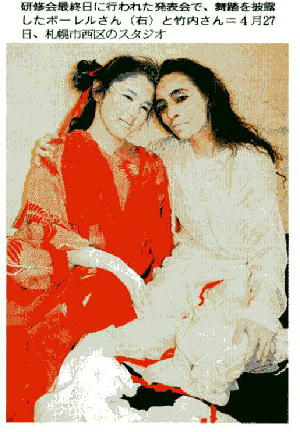|
A lower body paralyzed dancer, Tamar Borer,
Participated in Butoh workshop in Sapporo
@
| |
|
Handicap as onefs own individual characteristics, Butoh as passion
Butoh dancer Toshiharu Kasai (56 yrs), professor of Sapporo Gakuin University for body psychology, hosted this workshop. Borer and other participants from Denmark, U.S.A. and five Japanese dancers joined. Butoh dancer Mika Takeuchi (41yrs), active as Dance therapist, taught with Kasai for two weeks.
@
Smooth movements
At the closed Butoh presentations by the participants in the last day of the workshop, on the dim stage surrounded by about 20 audiences, Borer in a white costume was gradually showing her body through white cloths moving like a mollusk. Lying, sitting, she looked like a butterfly hatched out of a cocoon. Owing to her flexible and smooth movements, it is impossible to imagine her life with a wheel chair.
@Borer danced with Takeuchi in the latter half of her performance: Total about 30 minutes. Some were moved to tears to her performance, gI tried to express our spiritual journey and woman's lifeh, Borer said.
@Ohnofs Butoh performance Borer saw in Israel was his famous and most important Butoh piece gPraise for La Argentinah, a dedication to Argentina of Spanish dance. gIt was extremely original. I felt this should be my path of lifeh. At that time, Borer belonged to an Israeli dance company. Then, she started independently her own contemporary dance performances at the age 23, while studying classic ballet, modern dance, and Butoh dance.
@
Presupposed physical constrains
@At the age 24, a tragedy hit her. Her lower body was paralyzed by a car accident. By wishing that@gI wanted to overcome previous myselfh, Borer kept practicing, and visited Japan in 1992 to study at Ohnofs Butoh Institute in Yokohama. She later attended Butoh workshop of Yoshito Ohno (Ohnofs son) in Paris, 2006.
In Israel, together with Butoh performances, she has been having Dance therapy sessions, a mind-body therapeutic approach, to heal and ease mentally troubled soldiers in wars and suffering women from domestic violence and others through Butoh movements.
@She decided to come to Sapporo because the workshop purpose was to teach both Butoh as a dance and Butoh as a body psychotherapy.
She does not use a wheel chair while performing on the stage. gBecause of the lower body paralysis, my body expressions have become clearer and my performance naturally has developedh, Borer recollects.
@gIn Butoh, physical handicaps can be regarded as individual characteristics, with which you can express yourself in Butoh danceh, says Kasai, gDiversity represented by Borerf performance is Butohfs magnetism. Butoh can advantage a lot more peopleh.
@
|

|
[return to butoh/itto]